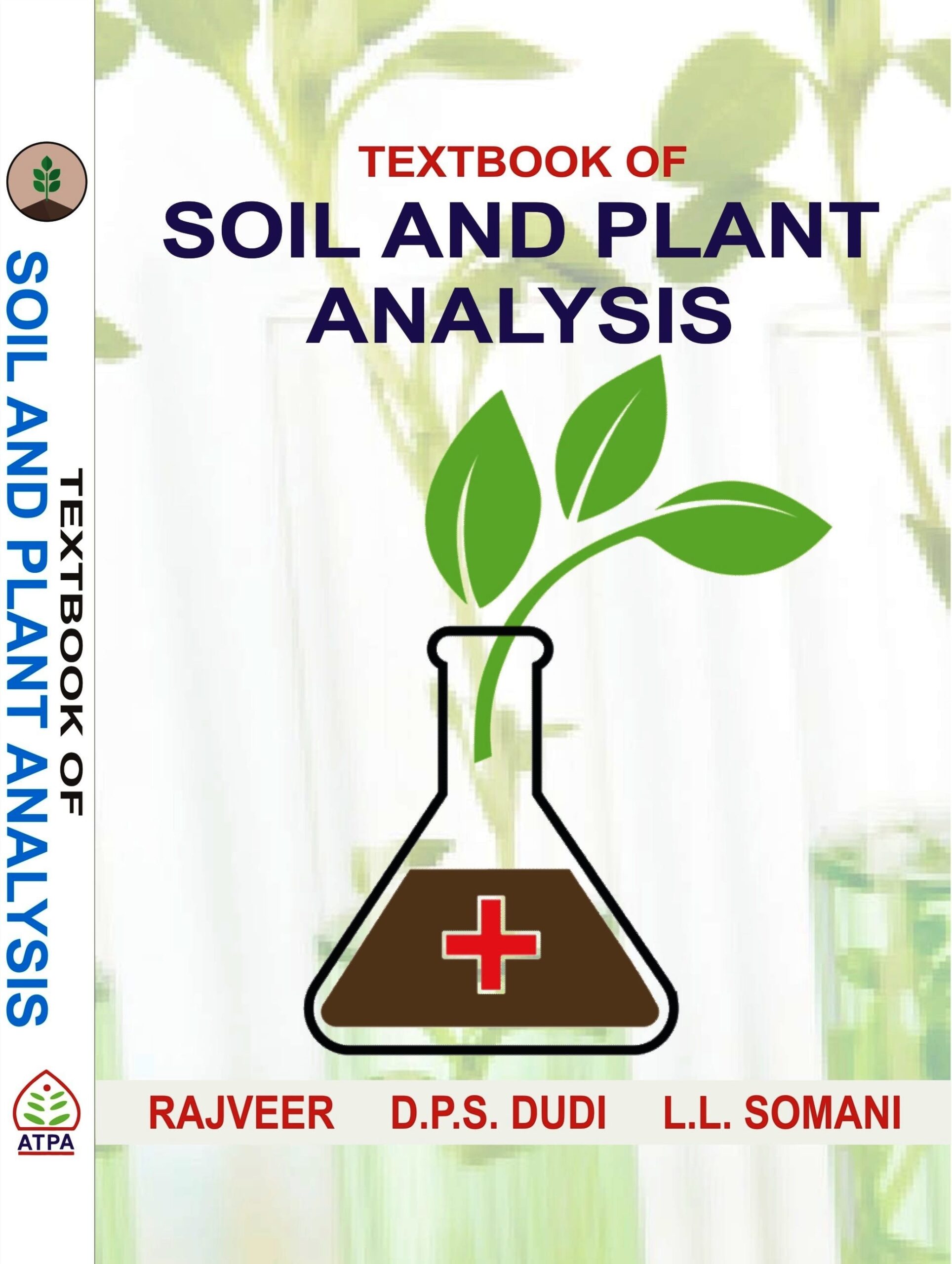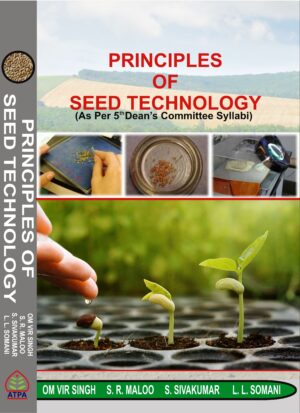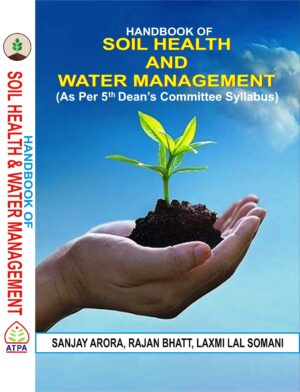TEXTBOOK OF SOIL AND PLANT ANALYSIS
₹750.00
AUTHORS: RAJVEER, D.P.S. DUDI AND L.L. SOMANI
PUBLISHING YEAR: 2022
ISBN: 9789390647279
© All Rights Reserved
Description
ABOUT THE BOOK
All scientists generally depend on analysis as a major means of solving scientific problems. This is to enable them offer solutions to numerous questions on the contents of the materials with which they work. The methods by which these analyses are carried out are referred to as analytical techniques. The types of analytical techniques may vary from field to field. This variation stems primarily from differences in the nature of materials with which people in each field works.
Soil science is branch of applied sciences that makes use of the principles of physics, chemistry, biology and mathematics in the study of soils and plants. This is because the soil consists of matter (living and non-living) interacting together physically, chemically and biologically to provide ecosystem services at all levels of consideration. For a soil scientist to be able therefore to answer questions on the constituents of soil, he needs to carry out one form of analysis or the other. Methods of analysis in soil science consist of chemical, biological and physical techniques.
The analytical procedures pertaining to soil and plant are dealt with under separate chapters. The analyrtical methods are chosen in such a way that they are applicabe under the conditions available in most of our soil science laboratories.
Efforts have been made to make the book comprehensive and easy to use. It is hoped that this book would be useful to students, teachers and researches in agriculture and related disciplines. The effort will be rewarding, if the student or researcher finds it handy for most of his requirements.
CONTENT
| TITLE | PAGE |
| Preface | 3-4 |
| About The Book | 5 |
| About The Authors | 6 |
| CHAPTERS | |
| 1.0 SOIL TESTING LABORATORY
1.1 Maintenance of a Chemical Analytical Laboratory 1.2 Glassware’s 1.3 Preparation of Reagents and Standard Solution 1.4 Preparation of Cleaning Solutions 1.5 Chromic-Sulphuric Acid Cleaning Solution 1.8 Instrumental Laboratory 1.7 Analytical Accuracy
2.0 IMPORTANT LABORATORY INSTRUCTIONS 2.1 Some Laboratory Requirements 2.2 Laboratory Apparatus 2.3 Solutions 2.4 Preparation of Standard Solution 2.5 Laboratory Sufety
3.0 SOIL ANALYSIS 3.1 Soil Sampling and Sample Preparation 3.1.1 Soil Sampling 3.1.2 Method of Soil Sampling 3.1.2.1 Soil Sampling Methods 3.1.2.2 Sampling Techniques 3.1.2.3 General Soil Sampling Guide lines 3.1.2.4 Soil Sampling Procedure 3.1.2.5 Methods for Subsampling Soils 3.2 Sampling of Waterlogged Soils 3.3 Preparation of Soil Sample in the Laboratory 3.3.1 Sampling Tools and Sample Preparation 3.4 Moisture Content in the Soil Sample 3.5 Particle Size Distribution Analysis A. International Pipette Method B. Bouyoucos Hydrometer Method 3.6 Bulk density of Soils (Undisturbed soil) 3.7 Keen- Raczkowski Measurements 3.8 Preparation of Saturation Extract 3.9 Determination of Saturation Percentage 3.10 Aggregate Size Distribution 3.10.1Dry Sieve Aggregate Analysis 3.10.2Wet Sieve Aggregate Analysis 3.11 Soil Moisture at Different Tensions 3.12 Hydraulic Conductivity 3.12.1Hydraulic Conductivity of Undisturbed Soil 3.12.2Hydraulic Conductivity of Disturbed Soil 3.13 Infiltration Rate 3.13.1Basin Method 3.13.2Cylinder Method 3.14 Soil Reaction 3.15 Exchangeable Acidity by Extraction with 1 M KCl 3.16 Extractable Acidity (Potential Acidity, Titrateable Acidity) 3.17 Organic Matter Determinations in Soil 3.17.1Loss on Ignition 3.17.2Organic Carbon (Walkley and Black’s Rapid Titration Method) 3.17.3Fractionation of Humus 3.17.4Fractionation of Organic Matter 3.18 Cation Exchange Capacity 3.19 Lime Requirement of Soil 3.19.1Buffer Method (Shoemaker et al.) 3.19.2Derivation from Exchangeable Al 3.20 Gypsum Requirement of soil 3.21 Determination of Calcium Carbonate in Soil 3.22 Determination of Total Elements 3.22.1Wet Digestion 3.22.1.1 Digestion for N 3.22.1.2 Digestion for P Ca, Mg, Fe, Al & Mn 3.22.1.3 Digestion for K, CU, &Zn 3.22.1.4 Digestion for Mo & Bo 3.22.2Fusion with Sodium Carbonate 3.23 Determination of Silica 3.24 Determination of Nitrogen in Soil 3.24.1Total Nitrogen (Microkjeldahl Method) 3.24.2Total Nitrogen (Macrokjeldahl Method) 3.24.3Available Nitrogen in Soil 3.24.4Determination of Ammonium Nitrogen 3.24.5Determination of Nitrite Nitrogen (NO2-N) 3.24.6Nitrate Nitrogen in Soil 3.25 Determination of Phosphorus 3.25.1Total Phosphorus 3.25.2Available Phosphorus in Soils 3.25.2.1 Extraction with Bray’s No. 1 Extractants 3.25.2.2 Extraction with Bray’s & Kurtz No. 2 3.25.2.3 Extraction with Olsen’s method 3.25.3Fractionation of Inorganic Phosphorus in Soil 3.25.4P Fixing Capacity of Soil 3.26 Determination of Potassium 3.26.1Total Potassium 3.26.2Available Potassium 3.26.3Cold Dilute H2SO4 Soluble Potassium 3.26.4Boiling HNO3 Soluble K 3.26.5K Fixing Capacity of Soils 3.27 Determination of Calcium and Magnesium 3.27.1Total Calcium and Magnesium 3.27.2Exchangeable Calcium and Magnesium 3.28 Determination of Sulphur 3.28.1Total Sulphur 3.28.2Available Sulphur 3.28.3Organic Sulphur 3.28.4Suphate Sulphur 3.29 Determination of Micro nutrient A. Determination by AAS 3.29.1Total Fe, Mn, Zn & Cu 3.29.2Available Fe, Mn, Zn & Cu 3.29.3Determination of Aluminium 3.29.3.1 KCI Extractable Al 3.29.3.2 Exchangeable Al- Titration Method B. Colorimetric Procedures for Micronutrients 3.29.4Determination of Iron 3.29.4.1 Dilute HCC Soluble Iron (Active Iron) 3.29.4.2 Available Iron (Ferrous iron) 3.29.5Determination of Manganese 3.29.5.1 Water Soluble Manganese 3.29.5.2 Exchangeable Manganese 3.29.5.3 Easily Reducible Manganese 3.29.6Determination of Molybdenum 3.29.6.1 Avaible Molybdenum 3.29.6.2 Hot Water Saluble Molybdenum 3.29.7Determination of Boron 3.29.8Determination of Available Copper 3.29.9Determination of Available Zinc 4.0 PLANT ANALYSIS 4.1 Collection and Preparation of Plant Samples for Analysis 4.2 Determination of Moisture 4.3 Determination of Crude Fibre 4.4 Digestion of Plant Samples for Estimation of Elements 4.4.1 Digestion for Nitrogen 4.4.2 Digestion for P, K, Ca, Mg, S, Fe, Mn, Zn, Cu 4.4.2.1 Di Acid Digestion 4.4.2.2 Triple Acid Digeation 4.4.2.3 Digestion for Mo 4.4.2.4 Digestion for Boron 4.5 Determination of Nitrogen 4.6 Determination of Phosphorus 4.7 Determination of Potassium 4.8 Determination of Calcium and Magnesium 4.9 Determination of Micronutrients 4.10 Determination of Chlorophyll Content 4.11 Determination of Oil Content 4.12 Determination of Fatty Acids 4.13 Determination of HCN Content 4.14 Determination of Phenols 4.15 Determination of Total Amino Acids
5.0 PREPARATION OF STANDARD CURVES FOR DIFFERENT ELEMENTS 5.1 Introduction 5.2 Biuret 5.3 Copper 5.4 Phosphorus 5.5 Potassium 5.6 Sulphate Sulphur 5.7 Zinc
6.0 IMPORTANT LABORATORY REAGENTS AND THEIR CHEMICAL CONTENTS 6.1 Reagents and Standards 6.1.1 Preparation and Standardisation 6.1.2 Molarities 6.1.3 Standardisation 6.1.4 Types of Laboratory Chemicals 6.2 Preparation of Important Chemicals
7.0 DOs and DO NOTs in Chemical Analysis 7.1 Dos 7.2 Do Nots
APPENDIX- I-XIV
Selected References
|
13-16
14 15 16 16 16 16 16
17-25 17 17 19 20 22
26-88 27 27 27 28 30 32 33 33 34 35 35 38 38 38 42 44 45 46 46 47 47 47 49 49 49 50 52 52 52 53 54 55
56 56 56
57 58 61 62 62 63 63 64 65 65 65 65 65 66 66 66 67 67 68 68 69 70 70 72 72 73 73 75 75 75 77 78 78 78 78 78 78 79 79 79 80 80 81 81 82 82 82 82 82 82 82 83 83 83 83 84 84 84 85 85 85 85 86 86 86 87 89-101 89
95 95 95
95 96 96 96 96 97 97 97 97 98 98 98 98 99 99 100 100
102-106
102 104 104 104 105 105 105
107-119
108 108 108 108 109 111
120-121 120 121
122-138
139-140 |
ABOUT THE AUTHORS
Mr. Rajveer S/o Choudhary Indersain Mali and mother Mrs. Dropati Devi was born in 1993 at village Bagicha, District- Sri Ganganagar (Rajasthan). He obtained his B. Sc Ag. (Hons) from SKRAU, Bikaner and M.Sc. (Ag.) Soil Science from SHUATS, Allahabad. Currently he is serving at Swami Keshwanand Rajasthan Agriculture University, Bikaner as Subject Matter Specialist (Soil Science). He has been exclusively working on different aspect of soil science for the last 5 years. He published many research papers in national and international journals, Seminar/ Symposia and popular articles in national level magazines. He has been recipients of many awards and recognitions including Student of the year Award-2013, Young Scientist Award-2016, Scientist of the year award-2017, Harit Purshkar-2018, etc., He is sitting member to many professional societies and organized 2 National seminars.
Dr. Dharm Pal Singh Dudi (b. 1968) has two years of experience in Mass Media Communication as Transmission Executive (Farm & Home) AIR-Udaipur besides over 17 years experience as Assistant Agriculture Reasearch Officer in Quality Control Laboratory in Fertilizers, & Pesticides Analysis (Department of Agriculture, Government of Rajasthan). Since 2013, Dr. Dudi is serving as Assistant Professor (Soil Science and Agricultural Chemistry), Rajasthan College of Agriculture, MPUAT, Udaipur, Dr. Dudi served as Councillor of Prestigious Indian Society of Soil Science (2020 to 2021). Dr. Dudi was honoured twice with Independence Day Awards for his outstanding contributions by the MPUAT. He has published and presented more than 24 peer reviewed research papers in National and International Journals of repute, 7 book chapters. He has vast experience of teaching of Under-graduate, Post-graduate and Ph.D. Programme, and research activities. He has guided 7 students for Post-graduate degree in Soil Science.
Prof. (Dr.) L.L. Somani (b. 1945) Retired Director (Rl) & Dean PG Studies, MPUAT Udaipur has over 400 papers published in National and International Journals/ Symposia, etc. and over sixteen dozen of books to his credit in different disciplines of Agriculture and allied fields. He held differentpositions in MPUAT, has spreaded highly innovative ideas, and programmes for development of Agriculture. Prof. Somani has been honoured with several awards
Additional information
| AUTHOR/AUTHORS | D.P.S. DUDI, L.L. Somani, RAJVEER |
|---|---|
| PAGES | 140 |
| BINDING | Hard Back |
| PUBLICATION YEAR | 2022 |





